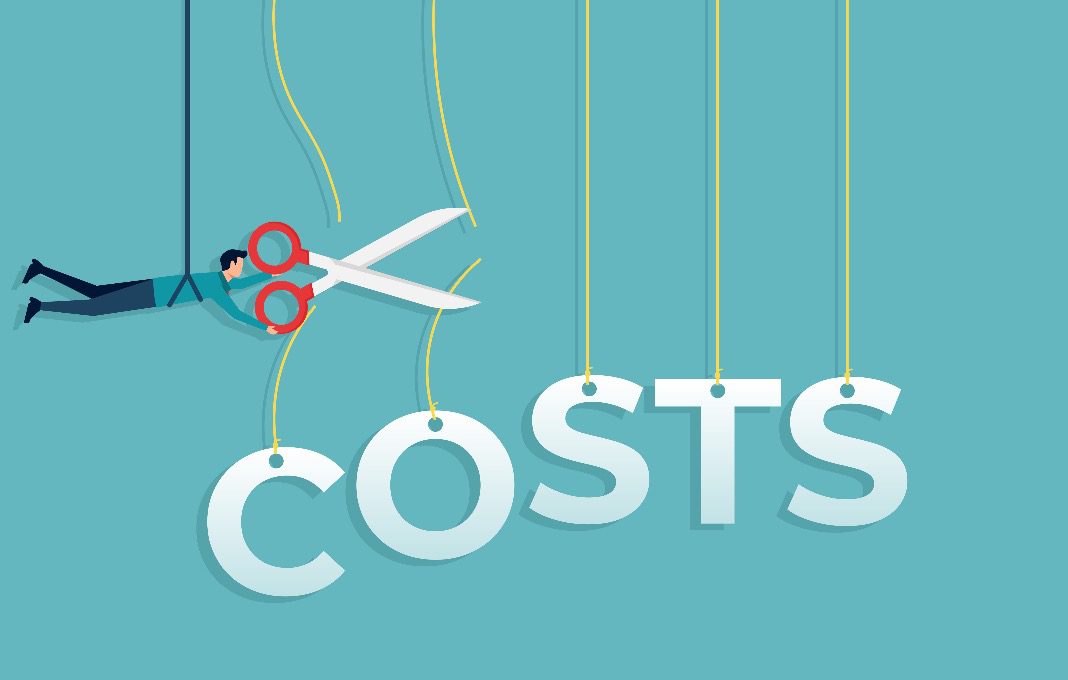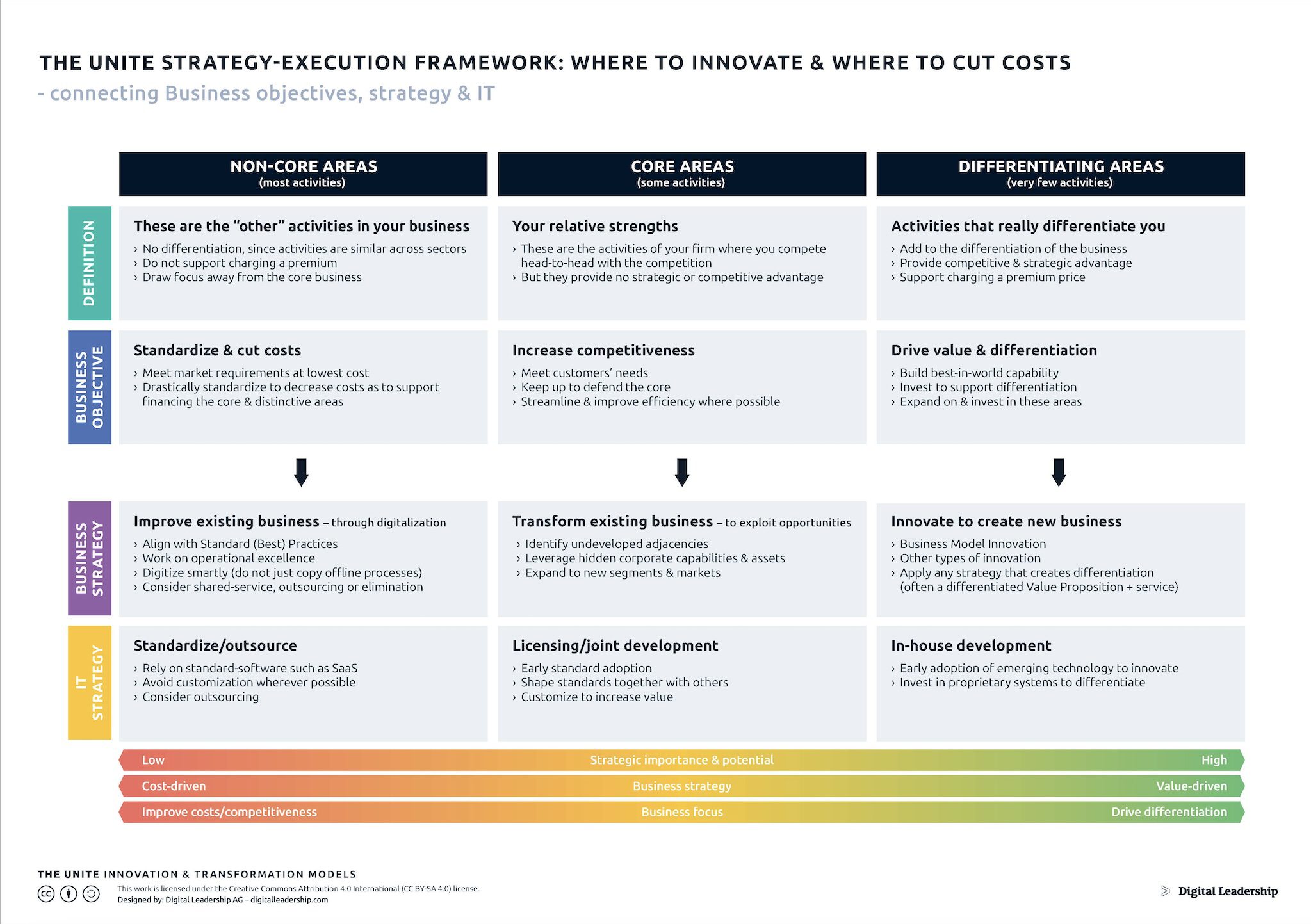


When I meet with senior executives from corporations, they often give me a number of excuses for why they don’t innovate and cannot innovate. The most often repeated excuse is that there is simply not enough budget. So how do you deal with this challenge? Where should you be cutting costs and where should you be innovating?
An astonishing 80% of an organization’s processes are not even specific to an industry. It doesn’t matter if you think about HR, finance, forecasting or marketing; by far, most of the processes and capabilities within those functions are not even specific to your industry—they are the same from Costco to JPMorgan Chase to IBM. Even supposedly core areas such as production are most often not specific to an industry: it is after all the same types of robots and machines that fabricate your products as they fabricate the products of other industries.
These types of processes and capabilities are an organization’s non-core activities. And importantly, it is unlikely that further investments into those areas will create a competitive advantage since they are not even specific to your industry. Further investment will typically only increase efficiency or decrease costs – an incremental improvement.
Your organization also has core activities: these are industry-specific and are areas where you possess relative strength. However, here you are competing head-to-head with other firms and are not superior to them.
Now contrast these with your differentiating areas. These are the activities where you are different from other organizations, and thus they are the areas that provide competitive advantage. These differentiating activities (and thus assets and capabilities) generally represent a small percentage of your total activities (approximately 2%–5%).
The distinction between core and non-core is critical, and yet most firms do not bother to make it. But it is precisely that distinction that allows you to understand where to cut cost and where to invest, where to work on creating a competitive advantage and where to standardize.
A typical error that corporations make during a crisis is implementing blanket cost-cutting measures across the board. While this approach might provide immediate financial relief, it inadvertently undermines long-term strategic positioning. When costs are slashed indiscriminately, essential differentiating activities—those unique aspects that set the company apart from competitors and underpin its competitive advantage—are also impacted. Reducing investment in these areas diminishes the organization’s ability to innovate and maintain market leadership, ultimately eroding the competitive edge that is crucial for recovery and future growth. Thus, a more nuanced approach, which protects and even bolsters differentiating capabilities while optimizing or outsourcing non-core functions, is essential for sustainable success.
Developing macro business strategies for your organization’s non-core, core and differentiating areas
Now the non-core, core and differentiating areas can be mapped to distinctive business and IT strategies. The UNITE Strategy-Execution Framework uniquely categorizes an organization’s activities into non-core, core, and differentiating areas and helps organizations align their strategy, business objectives, and IT to those.
Understanding these categories is essential for making informed decisions about where to allocate resources and how to achieve defined strategic objectives.

Non-core activities are areas of the business that, while necessary, do not contribute to differentiation or core business strengths. These activities often account for a significant portion of operational costs but do not directly enhance the organization’s competitive position.
1. Standardization: Implement standardized processes to ensure consistency and reduce complexity. You standardize by implementing the so-called “best practices”. Whenever you hear the term “best practice” think about “standard practice”: since everybody is applying those “best practices”, they are in effect “standard practices”, since they have no chances of creating a competitive advantage.
2. Automation: Automate repetitive and routine tasks to improve efficiency and reduce labor costs.
3. Outsourcing: Outsource non-core functions to specialized third-party providers who can perform these tasks more cost-effectively.
4. Operational Excellence: Focus on continuous improvement techniques such as Lean and Six Sigma to streamline operations and eliminate waste.
Core activities are essential to the business and involve functions where the organization competes directly with other companies. They are tpyically about 15% of all activities a business is running. While these areas do not inherently provide a competitive advantage, maintaining and strengthening competitiveness is crucial.
1. Process Improvement: Continuously seek ways to enhance processes to improve efficiency and effectiveness.
2. Adjacent Opportunities: Explore opportunities in adjacent markets or segments that can leverage your existing core capabilities.
3. Technology Integration: Integrate new technologies to improve productivity and maintain a competitive edge.
Differentiating activities are the unique aspects of the business that set it apart from competitors and provide a significant competitive advantage. These activities typically represent a small portion of the overall business (typically just 2-5% of an organization’s activities) but are critical for commanding premium prices and market leadership.
In the end you want to strengthen your organization’s differentation to build competitive advantage. You do so, by creating best-in class or best-in-world experiences: in essence, here you want to innovate with everything you got:
1. Business Model Innovation: Continuously explore and implement new business models that can create additional value and differentiation.
2. Customer Experience & service innovation: Invest in enhancing the customer experience and new services to build loyalty and differentiate the brand.
3. Product Innovation: Focus on developing new and innovative products that meet emerging customer needs and set the company apart in the market.
4. Research and Development: Allocate significant resources to R&D to drive breakthrough innovations that can redefine the market.
1. Assessment: Evaluate all activities and categorize them into non-core, core, and differentiating.
2. Resource Allocation: Allocate resources based on categorization, ensuring cost-efficiency in non-core areas and robust investment in differentiating activities.
3. Continuous Review: Regularly review and adjust strategies to stay aligned with market changes and organizational goals.
In today’s competitive landscape, knowing where to cut costs and where to innovate is critical for long-term success. By leveraging the UNITE Strategy-Execution Framework, organizations can strategically allocate resources, streamline operations, and drive innovation in areas that provide the most significant competitive advantage. This balanced approach ensures sustainable growth and market leadership.



0

1:00 - 5:00 pm
Over 70% of Executives Surveyed Agree: Many Strategic Planning Efforts Lack Systematic Approach Tips for Enhancing Your Strategic Planning Process
Executives expressed frustration with their current strategic planning process. Issues include:
Steve Rutan and Denise Harrison have put together an afternoon workshop that will provide the tools you need to address these concerns. They have worked with hundreds of executives to develop a systematic approach that will enable your team to make better decisions during strategic planning. Steve and Denise will walk you through exercises for prioritizing your lists and steps that will reset and reinvigorate your process. This will be a hands-on workshop that will enable you to think about your business as you use the tools that are being presented. If you are ready for a Strategic Planning tune-up, select this workshop in your registration form. The additional fee of $695 will be added to your total.

2:00 - 5:00 pm
Female leaders face the same issues all leaders do, but they often face additional challenges too. In this peer session, we will facilitate a discussion of best practices and how to overcome common barriers to help women leaders be more effective within and outside their organizations.
Limited space available.

10:30 - 5:00 pm
General’s Retreat at Hermitage Golf Course
Sponsored by UBS
General’s Retreat, built in 1986 with architect Gary Roger Baird, has been voted the “Best Golf Course in Nashville” and is a “must play” when visiting the Nashville, Tennessee area. With the beautiful setting along the Cumberland River, golfers of all capabilities will thoroughly enjoy the golf, scenery and hospitality.
The golf outing fee includes transportation to and from the hotel, greens/cart fees, use of practice facilities, and boxed lunch. The bus will leave the hotel at 10:30 am for a noon shotgun start and return to the hotel after the cocktail reception following the completion of the round.